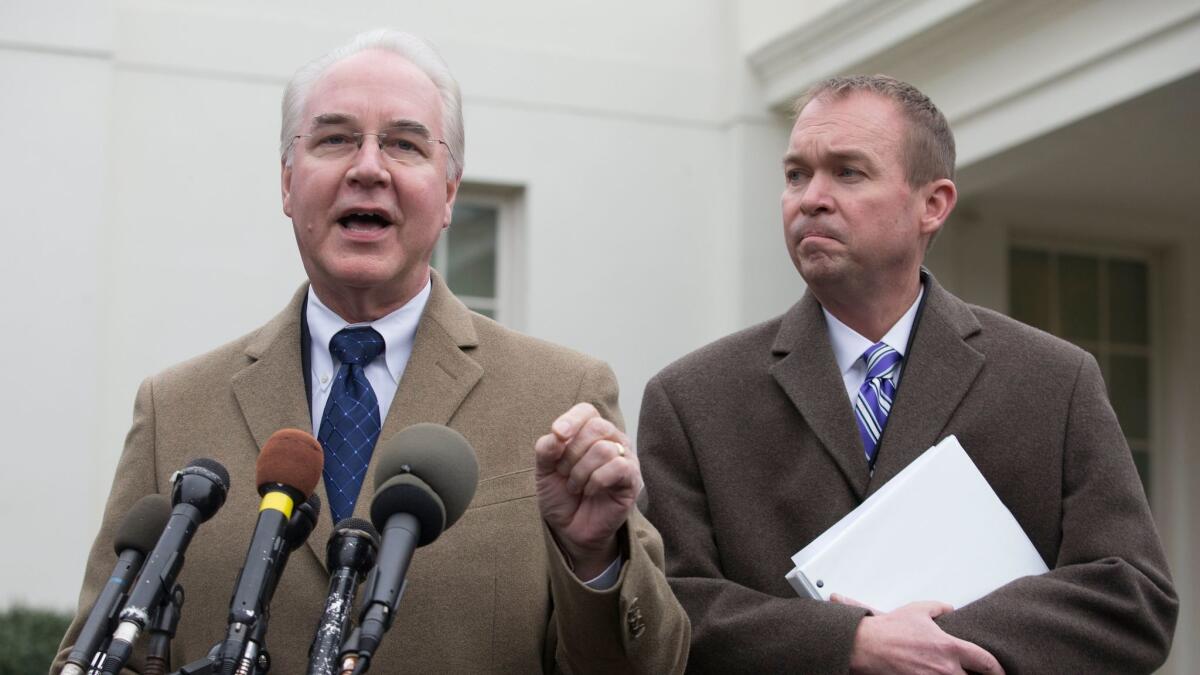Opinion: CBO shows how Trumpcare would save billions: by leaving millions uninsured

Which is a more pressing need in this country: spending fewer federal dollars, or making sure more people have health insurance?
The House GOP leadership’s proposal to “repeal and replace” Obamacare clearly focuses on the former at the expense of the latter. In a long-awaited report released Monday, congressional tax and budget analysts estimated that the measure — dubbed the American Health Care Act — would eventually cut federal spending significantly and lower insurance premiums for many younger consumers. But it would immediately leave 14 million more Americans without health insurance, with that number rising to 24 million within a decade.
That increase, which the report blamed on reductions in Medicaid and subsidies for private policies, would almost double the number of Americans lacking coverage. By contrast, Obamacare — formally known as the Patient Protection and Affordable Care Act — cut the percentage of uninsured Americans almost in half, to the lowest level in more than 50 years.
The analysis of the new House GOP bill was written by the Congressional Budget Office with help from the staff of the Joint Committee on Taxation. And though a top Trump administration official blasted the report as “just not believable,” some of its findings should actually help House leaders sell the bill to skeptical conservatives. In particular, Republicans will welcome estimates that the measure would reduce federal deficits by $337 billion over 10 years and, after initially driving up insurance premiums faster than current law, would lead to slower increases in later years.
What it won’t do, however, is make the bill more palatable to Democrats or critics in the healthcare industry because it predicts an even wider loss of insurance coverage than they’d feared. The loss would be driven by several factors, including more people choosing to go uninsured or being priced out of the market, states narrowing eligibility for Medicaid (the healthcare program for low-income Americans) and some employers dropping their group plans. None of those are welcome results.
A key question is whether it matters how many people have insurance coverage. Republicans have tried to argue that reducing the number of people on Medicaid isn’t necessarily a bad thing because it can be hard to find a doctor willing to see Medicaid patients. In other words, they argue, having Medicaid is no better than going uninsured.
That’s ridiculous on its face. Medicaid does have its problems, but none of them would be solved by slashing its funding, as the House GOP proposal would do. If you’re trying to make healthcare dollars go farther for low-income people, the key is to manage their care, particularly for their chronic conditions, not make it more haphazard and random.
The same could be said for the entire U.S. healthcare system, whose costs have been growing too rapidly for decades. We have to get more value for the money we’re spending on hospitals, doctors, drugs and devices. That means changing the incentives in the system to reward participants for keeping people healthy, not treating their ailments, and for embracing more efficient and effective treatments, not simply performing more procedures. Doing so will require a 180-degree shift for the industry — a change that the Affordable Care Act tried in several ways to encourage, but the House GOP proposal doesn’t even pay lip service to.
Instead, the Republican healthcare plan seeks simply to lower governments’ costs and trim the price of insurance without increasing the value it delivers. The CBO report predicts that by 2026, the bill would hold premiums 10% below where they would be if the ACA remained in effect. But it would do so by cheapening the product, while also making it harder for consumers in the non-group market to tell how little they were getting for their money. That part bears repeating: Not only would the House proposal eliminate the requirement that policies sold in the individual market cover at least 60% of the enrollee’s medical costs, it would free insurers from having to reveal how much of those costs their policies would cover.
Those distinctions may not matter to healthy people looking for cheaper policies than they can obtain today. But those who do need care would definitely not be served by policies with higher co-pays, higher deductibles and more exclusions. Nor would any consumers gain from changes in the market that make it harder to comparison-shop and to know the value of what you’re buying.
Intriguingly, the CBO report argues that one of the major fears about the House bill — that it will send the market for individual insurance policies into a death spiral, as fewer and fewer healthy consumers sign up — is overblown. Yes, eliminating the federal requirement to purchase coverage will lead millions of healthier people not to buy coverage, the report predicts. But the revised tax credits, even though they would be smaller for lower-income Americans, and billions of dollars in aid to help states keep their markets afloat should help maintain stability, the report predicted.
On the other hand, the report states that “the nongroup market would probably be stable in most areas under either current law or the legislation.” In other words, in the CBO’s view, the fears about the “collapsing” Obamacare exchanges that Republicans have been fanning with all their might are overblown too. And that blows a giant hole in the rationale for “repeal and replace.”
Twitter: @jcahealey
More to Read
A cure for the common opinion
Get thought-provoking perspectives with our weekly newsletter.
You may occasionally receive promotional content from the Los Angeles Times.











